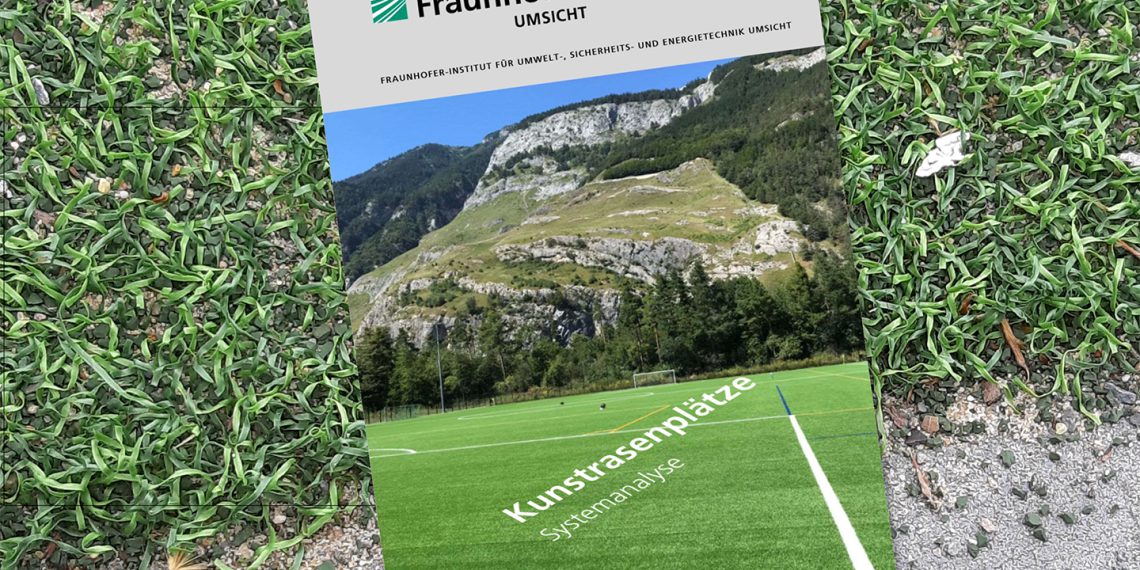Due to weather conditions, hard, ash and natural grass pitches are not always playable. Artificial turf, on the other hand, can be used all year round, making it a popular and widespread surface. However, this is accompanied by negative environmental impacts. This is shown by a system analysis of artificial turf pitches, which Fraunhofer UMSICHT has now published in a report. The report identifies topics such as the release of microplastics, recycling or site selection and at the same time provides recommendations on how those responsible can take countermeasures and make artificial turf fields more sustainable.
The FSB trade fair for open space, sports and exercise facilities will be held in Cologne from October 26 to 29, 2021. Sports fields and thus also artificial turf fields will play an important role there. The latter in particular have enormous relevance in this country, as they enable sports to be played outdoors all year round. This is also reflected in the system analysis of Fraunhofer UMSICHT, which was commissioned by various municipalities and companies, in that it specifies an average usage time of 1882 hours per field and year. According to the analysis, clay pitches, i.e. hard or ash pitches, on the other hand, are no longer considered to be up to date by both the clubs and the players. They have been increasingly converted in recent years — mostly into artificial turf pitches.
“Common artificial turf pitches, however, are associated with negative environmental impacts. Emissions from these pitches have become the focus of society, politics and the media in the context of the debate about microplastics.”
- Juergen Bertling
A team of scientists* studied a total of 19 artificial turf pitches in Germany and Switzerland. Based on analyses, data collection and surveys, the published report describes and evaluates the current status and makes recommendations for more sustainable sports field construction. The report addresses the planners and manufacturers as well as the operators and users.
Almost 3 tons of material lost per pitch per year
To positively influence playing performance, a so-called infill is applied to artificial turf pitches. In the majority of the pitches examined, this consists of sand and a rubber granulate. Uninfilled pitches and those with the natural material cork are currently the exception.
Observations show that especially during heavy rain or wind, the infill gets into the surrounding area, where it collects or even ends up in bodies of water, for example. In addition to weather-related emissions, cleaning activities such as snow shoveling and the players themselves have a major influence on material discharge: they take the material with them in their shoes and on their clothing. On average, the experimentally determined annual loss of the artificial turf fields studied can be put at 2.98 tons of infill per year. “Synthetic fibers, which also wear out during the use of a pitch, have not yet been taken into account here,” adds Jürgen Bertling. More detailed studies are needed here, he says, to clarify whether the losses actually reach relevant quantities. Even after the study, it remains unclear through which pathways and in what quantities the losses of infill and fibers reach the soils and water bodies.
Another important aspect of the system analysis is the consideration of the CO2 footprints of artificial turf pitches. Depending on the pitch type, these range from 9.4 to 29.8 kg of carbon dioxide equivalent[1] per hour of use. By way of comparison, this is significantly less than driving a car for an hour or swimming in an indoor or outdoor pool.
Great potential for improved environmental protection
The system analysis shows that the environmental impact of an artificial turf pitch depends to a large extent on the choice of materials, structural integration and recycling at the end of its life cycle. The experts see great potential here — starting with the use of a more sustainable material for the substructure and infill, through the use of rainwater for irrigation, to the filtering of fines. Barriers surrounding the site would additionally reduce microplastic emissions into the environment. “We also address the issue of location. After all, it makes a big difference whether an artificial turf pitch is located in an urban environment or, say, in a valley surrounded by nature. In the future, more attention should be paid to a clever choice of location with regard to nature conservation, but also with regard to the frequency of use by players and thus the need for a pitch,” says Jürgen Bertling. And last but not least, the regulatory side must also be considered as a steering instrument, for example by revising norms or creating new standards.
Majority of players want more environmentally friendly artificial turf pitches
Both active and former players are very involved in the debate on the relevance and environmental impact of artificial turf pitches. The majority of those surveyed as part of the system analysis support the statement that the pitches need to become more sustainable. Although rubber granules are still preferred as the infill type, people are definitely open to more environmentally friendly alternatives.
According to the scientists, these are good conditions for achieving a compromise between intensive use of the pitch and a minimum negative impact on the environment.

















